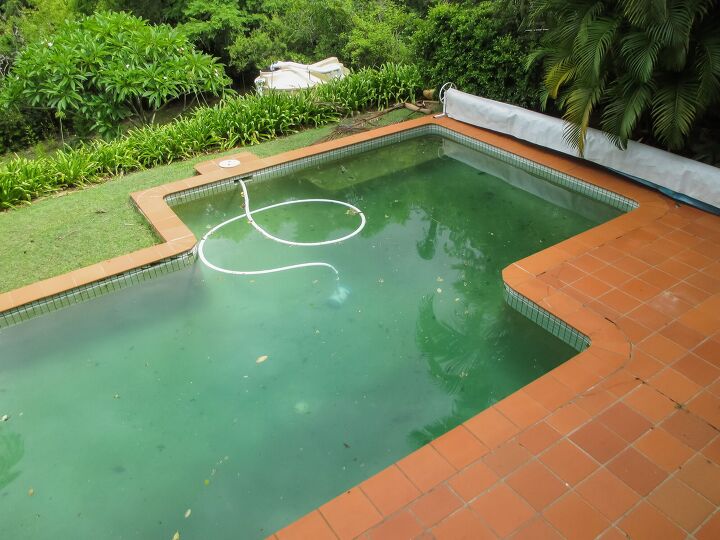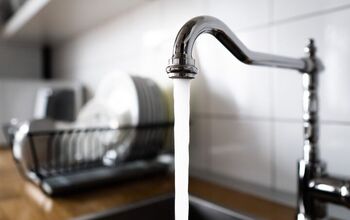Why Is Pool Water Cloudy?

Cooling off and splashing around in the pool is one of the highlights of summer. But it’s not so cool if you’re dealing with green pool water or a cloudy pool. In this article, we’re going to focus on the reasons your pool water is cloudy.
Pool water gets cloudy from inefficient chlorine in the water, leading to pathogens and algae. Too much chlorine, excessive chemicals, and imbalanced pH levels also lead to cloudy water. Avoid swimming in a cloudy pool and treat it quickly to avoid damaging your pool filter. Shock the pool and use a clarifier to clear the water, then test the levels before swimming.
If your pool’s looking less than desirable during the sweltering summer heat, you understandably want to clear things up quickly. Maintaining your pool takes some work, but it’s well worth the effort. Knowing how to solve common problems, like cloudy pool water, makes things easier.
6 Reasons For A Cloudy Pool
Testing your pool water regularly is an important part of summertime pool maintenance. Keeping up with routine testing increases the odds that your pool stays ready and waiting for you whenever you feel like jumping in.
Test the chlorine and pH levels in your pool a few times a week, and test alkalinity weekly. If you use your pool every day or have large numbers of people in the pool, test chlorine levels daily. Make sure to know the best testing schedule for your pool and stick to it.
1. The Pool Filter Isn’t Working Properly
Check your pool’s filter to ensure it’s working properly. A clogged filter can’t do what it needs to do, leading to stagnant water. If you don’t run the filter enough, this can also lead to cloudy pool water.
Another possibility is your pool’s pump isn’t working. You may need to replace it or call in a pool tech.
2. Poor Chlorine Levels Or Imbalanced pH
One of the biggest reasons for cloudy pool water is messed-up chlorine or pH levels. It’s important for pH levels to be in balance so the chlorine in your pool works correctly. Otherwise, free chlorine (FC) in the water decreases, leading to lower pH levels, and an increase in combined chlorine.
Low free chlorine is a leading cause of cloudy water, and you likely will notice an intense chlorine smell. This odor is due to too much chloramine in the water, which inhibits the chlorine from cleaning your pool effectively. It also contributes to ammonia and algae growth in your pool.
High pH levels will render chlorine ineffective, leading to the growth of algae and other organisms. Ineffective chlorine also means you’re more likely to have bacteria in the water.
Follow the instructions on your pool-care chemicals or equipment to know what your levels should be. For pools, the CDC recommends free chlorine of at least 1 ppm and a pH range between 7.2 and 7.8.
3. High Alkalinity And Calcium Hardness
High total alkalinity (TA) also leads to cloudy pool water. Once again, it comes down to your pH levels. High TA can imbalance the pH and cause calcium scaling.
Too much calcium in the water also contributes to cloudiness. Maintain proper alkalinity and calcium levels according to your pool to keep everything within balance.
4. Various Debris And Particles In Pool Water
Things like body oils, make-up, sunscreen, and sweat add up as people swim in the pool. These elements collect in the water and reflect light, giving off a cloudy look.
Leaves, flower petals, bugs, pollen, bird poop, and other debris cause hazy water. These things also get into your pool’s filter and impede its performance. The lack of filtration, as previously mentioned, contributes to a cloudy pool.
5. A Recent Rainstorm
If you notice your pool looking cloudy following a big storm event, the rain is the likely culprit. Rainwater contains a variety of minerals and elements that run into your pool and throw off the balance. Plus, heavy rain can dilute the chlorine and other chemicals in your pool, rendering them useless.
6. The Early Signs Of Algae
In some situations, although not the most likely, your pool water can look cloudy because of the very beginnings of algae growth. Improper free chlorine levels contribute to algae growth.
Is It Okay To Swim In A Cloudy Pool?
As tempting as it is to ignore cloudy pool water when it’s 100 degrees outside, don’t take the leap. Swimming in a cloudy pool poses a few safety hazards.
- You potentially expose yourself to harmful bacteria, like E. Coli and other organisms. Swimmers could experience stomach problems, infections, skin issues, and eye irritation.
- You might be swimming in pee, blood, sweat, and other unpleasant contaminants. This is gross, to say the least, but it can also make you sick.
- When the pool gets really cloudy, it’s difficult to see the bottom. It can also be hard to notice swimmers in trouble, so it’s best to avoid swimming in a cloudy pool.
How Do You Treat Cloudy Pool Water?
Get ready to say goodbye to cloudy pool water so you can get back to splashing and swimming.
1. Check The Filter And Pump
Check the pool pump and filter to make sure they’re in good shape. Clean the filter and verify that it’s the correct type and size for your pool. Replace parts if necessary.
Proper maintenance goes a long way in keeping your pool crystal clear. If you use your pool a lot, run the filter all the time. However, for typical residential use, running the filter for 8 to 10 hours a day is sufficient.
2. Clean The Pool As Needed
Use a skimmer to remove any large, visible pieces of debris. Vacuum the pool and scrub the surfaces. Running a pool vacuum regularly helps stay on top of dirt and debris that get in the pool.
3. Check Chlorine
Test the chlorine levels and adjust accordingly. In summer, when temperatures rise, it’s super important to stay on top of chlorine checks. Sun exposure and heat deplete chlorine. Test the chlorine levels and adjust as needed to get them within the proper range for your pool.
If free chlorine is too low or combined chlorine is too high, you need to shock your pool. Follow the directions on the pool shock. Typically, you’ll need to wait for 24 hours after shocking your pool before you can use it. However, always test your levels first before swimming.
4. Rebalance pH Levels
Use a pH reducer or increase if your levels are too low or too high. It may take a few times before the pH level balances.
5. Reduce Calcium If Too High
If excessive calcium or calcium hardness is the issue, your most likely course of action is to partially drain and refill some of your pool. Backwash and clean the filter, then recheck and rebalance your levels.
6. Try A Pool Clarifier
Using a pool clarifier might be all you need if when you test your water levels everything is in balance. Always follow the directions on the product.
After applying the clarifier, run your filter continuously for one to two days and backwash the filter. Recheck your levels and rebalance them as necessary. If you opted to shock the pool, wait a couple of days before using a clarifier.
What If My Saltwater Pool Is Cloudy?
If you have a saltwater pool, you add salt instead of chlorine, and a chlorinator converts the salt to free chlorine. Follow similar steps to get your saltwater pool clear.
Check the mechanical components, including the chlorinator. Test the water levels and balance the pH as necessary. Measure the salt levels, adjust and clean the chlorinator, and finally, shock the pool. If cloudiness remains, try adding a clarifier a couple of days after shocking.
How Long Does It Take To Clear A Cloudy Pool?
When following the above steps, including shocking the pool, you should get clear pool water within two to three days.
Enjoy A Crystal Clear Pool This Summer
Swimming in a cloudy pool isn’t a good idea. Check the filter and pump, clean the pool, and test the water levels.
Adjust chlorine and pH as necessary, and prepare to shock the pool. If the pool still seems a little cloudy or is only mildly hazy, using a clarifier is a good step. If too much calcium/calcium hardness is to blame, you likely need to partially drain and refill the pool.
Don’t jump in the pool if the water doesn’t look clear. As much as you want to cool off and have some summertime fun, it’s not worth the potential risk. First, figure out why the pool’s cloudy, clear it up, then you can say, “Come on in, the water’s fine.”
Related Guides:

Stacy Randall is a wife, mother, and freelance writer from NOLA that has always had a love for DIY projects, home organization, and making spaces beautiful. Together with her husband, she has been spending the last several years lovingly renovating her grandparent's former home, making it their own and learning a lot about life along the way.
More by Stacy Randall



























